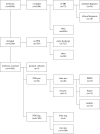Effectiveness of neonatal pulse oximetry screening for detection of critical congenital heart disease in daily clinical routine--results from a prospective multicenter study
- PMID: 20195633
- PMCID: PMC2890074
- DOI: 10.1007/s00431-010-1160-4
Effectiveness of neonatal pulse oximetry screening for detection of critical congenital heart disease in daily clinical routine--results from a prospective multicenter study
Abstract
Pulse oximetry screening (POS) has been proposed as an effective, noninvasive, inexpensive tool allowing earlier diagnosis of critical congenital heart disease (cCHD). Our aim was to test the hypothesis that POS can reduce the diagnostic gap in cCHD in daily clinical routine in the setting of tertiary, secondary and primary care centres. We conducted a prospective multicenter trial in Saxony, Germany. POS was performed in healthy term and post-term newborns at the age of 24-72 h. If an oxygen saturation (SpO(2)) of <or=95% was measured on lower extremities and confirmed after 1 h, complete clinical examination and echocardiography were performed. POS was defined as false-negative when a diagnosis of cCHD was made after POS in the participating hospitals/at our centre. From July 2006-June 2008, 42,240 newborns from 34 institutions have been included. Seventy-two children were excluded due to prenatal diagnosis (n = 54) or clinical signs of cCHD (n = 18) before POS. Seven hundred ninety-five newborns did not receive POS, mainly due to early discharge after birth (n = 727; 91%). In 41,445 newborns, POS was performed. POS was true positive in 14, false positive in 40, true negative in 41,384 and false negative in four children (three had been excluded for violation of study protocol). Sensitivity, specificity, positive and negative predictive value were 77.78%, 99.90%, 25.93% and 99.99%, respectively. With POS as an adjunct to prenatal diagnosis, physical examination and clinical observation, the percentage of newborns with late diagnosis of cCHD was 4.4%. POS can substantially reduce the postnatal diagnostic gap in cCHD, and false-positive results leading to unnecessary examinations of healthy newborns are rare. POS should be implemented in routine postnatal care.
Figures


Comment in
-
Neonatal pulse oxymetry as a screening for congenital heart disease: single or double recordings?Eur J Pediatr. 2010 Dec;169(12):1569; author reply 1571-2. doi: 10.1007/s00431-010-1262-z. Epub 2010 Jul 28. Eur J Pediatr. 2010. PMID: 20665219 No abstract available.
References
-
- Byrne BJ, Donohue PK, Bawa RD, et al. Oxygen saturation as a screening test for critical congenital heart disease [abstract] Pediatr Res. 1995;37(Suppl):198A. - PubMed
Publication types
MeSH terms
LinkOut - more resources
Full Text Sources
Medical
Miscellaneous

